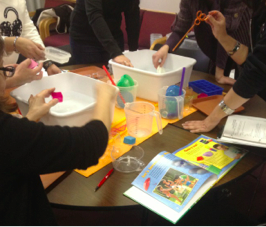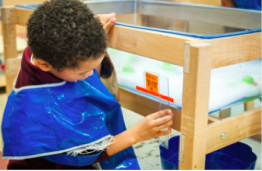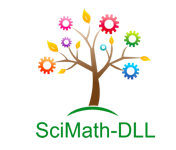
Early STEM – Fuel for Learning
October 6, 2015

José, a preschooler in Mrs. Hardy’s classroom, had never talked in class. He was a dual language learner (DLL), and it was already December. His teacher was participating in our SciMath-DLL professional development project where she had been learning about how to incorporate more science, technology, engineering, and mathematics (STEM) into her classroom and how to engage DLLs in these activities. One day, she set out ramps and cars and let the kids play with them. Then she asked the children if they knew how they might make the cars go down the ramps more quickly? “Blocks!” said José, as he ran to the block center to get blocks to prop up his ramp. His classmate, Molly, looked shocked and said, ‘He talked!” This child’s teacher was amazed at how rich (although relatively simple) STEM materials provided the fodder needed to encourage José to express himself out loud.
Children are natural scientists and are curious about their world. Even infants have an innate sense of quantity that is the foundation for more complex mathematics, such as counting and geometry (e.g., Hespos et al., 2012). Young children–including my 19-month-old–love to throw or drop objects down the stairs to observe what will happen . . . over and over again. Although not fully verbalized, they are conducting trials to test out a hypothesis about gravity and the physics of movement based on prior experience!
SciMath-DLL is a professional development model that aims to embrace these natural predispositions, to help teachers find the STEM in what children are already doing, and to design their own intentional learning experiences for their children. SciMath-DLL seeks to improve the quality of early STEM teaching and learning for all children, including DLLs. This is important. Recent research that has found that how children do in math and science by the end of preschool predicts how well they will do in these subjects later–even into adolescence (Duncan et al., 2007; Watts et al., 2014; Grissmer et al, 2010)! And early math skills predict later reading skills too–even better than early reading skills predict later reading. Unfortunately, many children and especially children who live in low-resource communities or who are DLLs, start preschool behind their peers in key domains and stay behind without intervention (Barnett, 2008; Denton & West, 2002).

The challenge is that many early childhood educators do not have the confidence or background knowledge to teach STEM effectively (Greenfield et al., 2009) or to work with DLLs (Freedson, 2010). Many educators did not participate in many–or any–STEM courses in their pre-service preparation programs (Zaslow et al., 2010). Our model aims to address this issue by using key STEM concepts as focal points at in-service interactive workshops, Professional Learning Communities (PLCs), and individual Reflective Coaching Cycles (RCCs). We weave throughout all components our approach to teaching STEM to young children. For example, we encourage educators to look for the STEM in every day activities (e.g., figuring out how many orange slices are needed at snack time so every child gets one), to thoughtfully expand the language strategies they use with children (e.g., “Emmanuel said he thinks the metal ball will sink in water. Emmanuel, why do you think that?”), to incorporate literature into STEM activities (fiction and nonfiction), and to “think outside the kit” when gathering materials to explore (e.g., using found or recycled materials to explore sorting).

One teacher who was working with us–Ms. Anabela–who had done a length measurement lesson with her kids using worksheets and different types of units, reflected on her lesson: “My first lesson was a complete disaster because I had too much going on . . . After we talked about it, and I was like duh. The objective was there; the idea was there; the whole mapping it out, though, was not.” Ms. Anabela, in a later class, asked her kids how they might measure themselves using blocks on the rug. The teacher’s and children’s ideas of what measurement could look like expanded. The students were so excited to find out who was taller, that they asked Ms. Anabela and then the assistant teacher to be measured as well. The kids found additional ways to do measurement around the classroom to solve real problems (e.g., keeping track of the height of the water in the water table).
Just as José and Ms. Anabela found concepts that fueled their interests and promoted learning across STEM and language, we hope that other children and teachers will find the joy in STEM that encourages and motivates them to push their own learning and teaching boundaries. SciMath-DLL works with teachers to reflect on their practice, build their STEM knowledge base, and enrich their teaching using an innovative approach to professional development. We view our model as collaborative, with all of us bringing our own expertise to the table in a common goal to improve STEM learning for all young children.

To learn more about SciMath-DLL, please visit scimathdll.com, or email us! Dr. Alissa Lange, Principal Investigator (alange@nieer.org) Hebbah El-Moslimany, Project Coordinator (he-lmoslimany@nieer.org).
Work presented here is made possible by grants from the National Science Foundation (DRL-1019576 & DRL-1417040). Any opinions, findings, and conclusions or recommendations expressed in this material are those of the author(s) and do not necessarily reflect the views of the National Science Foundation.
–Alissa A. Lange, Assistant Research Professor, NIEER
About NIEER
The National Institute for Early Education Research (NIEER) at the Graduate School of Education, Rutgers University, New Brunswick, NJ, conducts and disseminates independent research and analysis to inform early childhood education policy.
